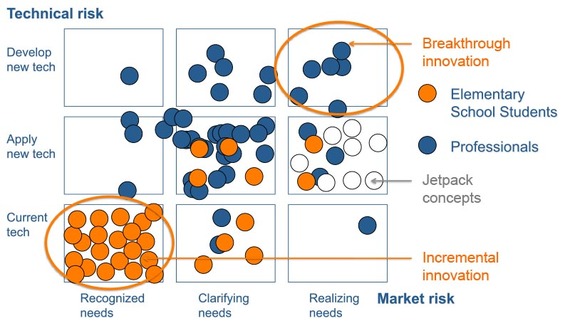We all marvel at the creativity of children because they are full of energy, uninhibited and inquisitive. When they draw, the worlds they invent make us smile with pride. Are children naturally more innovative than adults and, if so, does that help to make them great designers?
We invited eighty of the fifth through eighth grade students from Nalanda Public School in Mumbai (part of the Clinton Global Initiative), India and sixty experienced design professionals from Seoul, Hong Kong and Copenhagen to create innovative concepts. The students were asked to design backpacks for students living in Copenhagen, Denmark and their designs were then compared with that of the designers, who had been asked to design a wide range of consumer products.
To gain an overview of the creativity of the two groups, we then positioned their concepts in a Market - Technology risk matrix. From this vantage, we could see that the students mainly came up with incremental concepts, while the designers were generating a wider range of breakthrough market and technology innovations.
The fact that children mainly think up incremental designs probably comes as no surprise. Design is a recombination of existing elements and children, by virtue of their youth, have yet to build up a knowledge base of other's needs, wants and desires. They are also only in the early beginning stages of gaining an understanding of the solutions available to fulfill these desires.
The students' lack of knowledge and experience with other cultures meant they projected their own needs onto others. For example, they proposed backpacks with special holders for cricket bats and air-conditioning, although Danes do not play cricket and the Nordic weather certainly does not require any more cooling.
Their limited understanding of technology resulted in designs with jetpacks strapped to the backpacks. One group of students envisioned Danish children jetting through Copenhagen on their way to school. The jetpack idea may have come from the successful Indian space program or an animated Hollywood movie however; this idea took hold like wildfire among the student group.
The findings imply that education and life experience do make for more creative thinking. Would a design education then be wasted on elementary school students? Not necessarily... With hindsight, it becomes apparent that learning about the design process, brainstorming and mind mapping in elementary school, rather than waiting until college, could have been of tremendous benefit in my own early academic career.
Judging from the energy and enthusiasm the Mumbai students displayed during their two-hour long design session - children thrive on design challenges. They love to learn new things and translate them into ideas of their own. Their sketches exuded passion and joy, something that can only help them in the future at becoming the very best that they can be in their chosen fields of endeavor.
It is important to keep a child-like innocence and open-mindedness throughout one's life. However, years of learning are required in order that one's contribution to change in the world be breakthrough and not simply incremental. In order to "Be the change that you wish to see in the world" (Mahatma Gandhi), building knowledge and experience about the social sciences as well as the natural sciences, may offer one the best chance of a successful contribution to life.

